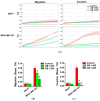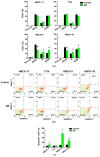Effects of Garlic on Breast Tumor Cells with a Triple Negative Phenotype: Peculiar Subtype-Dependent Down-Modulation of Akt Signaling
- PMID: 38786044
- PMCID: PMC11119207
- DOI: 10.3390/cells13100822
Effects of Garlic on Breast Tumor Cells with a Triple Negative Phenotype: Peculiar Subtype-Dependent Down-Modulation of Akt Signaling
Abstract
Breast cancer includes tumor subgroups with morphological, molecular, and clinical differences. Intrinsic heterogeneity especially characterizes breast tumors with a triple negative phenotype, often leading to the failure of even the most advanced therapeutic strategies. To improve breast cancer treatment, the use of natural agents to integrate conventional therapies is the subject of ever-increasing attention. In this context, garlic (Allium sativum) shows anti-cancerous potential, interfering with the proliferation, motility, and malignant progression of both non-invasive and invasive breast tumor cells. As heterogeneity could be at the basis of variable effects, the main objective of our study was to evaluate the anti-tumoral activity of a garlic extract in breast cancer cells with a triple negative phenotype. Established triple negative breast cancer (TNBC) cell lines from patient-derived xenografts (PDXs) were used, revealing subtype-dependent effects on morphology, cell cycle, and invasive potential, correlated with the peculiar down-modulation of Akt signaling, a crucial regulator in solid tumors. Our results first demonstrate that the effects of garlic on TNBC breast cancer are not unique and suggest that only more precise knowledge of the mechanisms activated by this natural compound in each tumor will allow for the inclusion of garlic in personalized therapeutic approaches to breast cancer.
Keywords: Akt; PDX-derived cells.; TNBC subtypes; breast cancer; garlic extract.
Conflict of interest statement
The authors declare no conflicts of interest.
Figures










Similar articles
-
Calycosin inhibits triple-negative breast cancer progression through down-regulation of the novel estrogen receptor-α splice variant ER-α30-mediated PI3K/AKT signaling pathway.Phytomedicine. 2023 Sep;118:154924. doi: 10.1016/j.phymed.2023.154924. Epub 2023 Jun 14. Phytomedicine. 2023. PMID: 37393829
-
Rhizoma Amorphophalli inhibits TNBC cell proliferation, migration, invasion and metastasis through the PI3K/Akt/mTOR pathway.J Ethnopharmacol. 2018 Jan 30;211:89-100. doi: 10.1016/j.jep.2017.09.033. Epub 2017 Sep 27. J Ethnopharmacol. 2018. PMID: 28962890
-
Diallyl disulfide inhibits growth and metastatic potential of human triple-negative breast cancer cells through inactivation of the β-catenin signaling pathway.Mol Nutr Food Res. 2015 Jun;59(6):1063-75. doi: 10.1002/mnfr.201400668. Epub 2015 Apr 29. Mol Nutr Food Res. 2015. PMID: 25755089
-
Therapeutic activity of DCC-2036, a novel tyrosine kinase inhibitor, against triple-negative breast cancer patient-derived xenografts by targeting AXL/MET.Int J Cancer. 2019 Feb 1;144(3):651-664. doi: 10.1002/ijc.31915. Epub 2018 Nov 7. Int J Cancer. 2019. PMID: 30289981
-
Vav1 downmodulates Akt in different breast cancer subtypes: a new promising chance to improve breast cancer outcome.Mol Oncol. 2018 Jun;12(7):1012-1025. doi: 10.1002/1878-0261.12203. Epub 2018 May 16. Mol Oncol. 2018. PMID: 29658179 Free PMC article.
Cited by
-
Metabolic Profiling of Breast Cancer Cell Lines: Unique and Shared Metabolites.Int J Mol Sci. 2025 Jan 24;26(3):969. doi: 10.3390/ijms26030969. Int J Mol Sci. 2025. PMID: 39940737 Free PMC article.
References
Publication types
MeSH terms
Substances
Grants and funding
LinkOut - more resources
Full Text Sources
Medical
Research Materials

